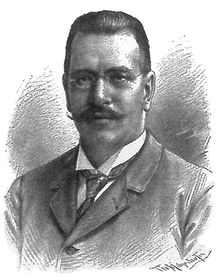Happy Brothers
One art historian suggests the painting was influenced by the works of Rosa Bonheur and Gustave Courbet, while another believes it was informed by those of the satirists William Hogarth and Honoré Daumier.
"[2] According to Predić, the painting shows four intoxicated youths who have been drinking all night walking rowdily through their village around dawn and waking all their neighbours.
[c] She begins to shout at him and threatens to spank him once he returns, but the young man simply laughs and sends her an acknowledging wave with his hat.
[8] The art historian Lilien Filipovitch-Robinson posits that the painting is informed by the progressive style of French realists such as Rosa Bonheur and Gustave Courbet.
She concedes that there is no documentary evidence to suggest Predić was influenced by Courbet's depictions of peasant life, but notes that the latter's work was in the public domain at the time Happy Brothers was created and was quite popular throughout Europe.
Filipovitch-Robinson believes that Predić rejected the precision and linearism of both Academic and Biedermeier art, and, as Courbet would have done, used heavily textured brushstrokes to define the roughness of the muddy road.
She also draws parallels between the painting and Courbet's Peasants of Flagey, which was shown at the Paris Salon of 1850–51 alongside The Stone Breakers and A Burial At Ornans.
"Perhaps this was due to the inherent limitations of his subject", she writes, "the fact that the figures are not caricatured and that the painting is devoid of biting or mocking humor".
[6] According to Filipovitch-Robinson, Predić's treatment of Balkan rural life differs in a number of ways from that of his contemporary Paja Jovanović, who was known for painting similar subjects.
This painting also brings Predić much closer to the more daring experimentations of the Munich School not only because of the textural play of the mud-laden soil against rough peasant garb but in his convincing presentation of the atmosphere of the quiet predawn hours.
[2] Writing for the Novi Sad-based publication Javor in 1890, the critic Milan Rešetar ranked the painting among Predić's finest works up to that point.
The magazine praised Predić as "a true artist ... one who isn't afraid to use his talent to educate people and nurture the nobler aspects of human nature".


